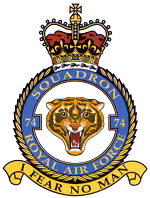
Back 74è Esquadró de la RAF Catalan No. 74 Squadron German No. 74 Squadron RAF French No. 74 Squadron RAF Polish Esquadrão N.º 74 da RAF Portuguese
| No. 74 Squadron RAF | |
|---|---|
 | |
| Active | 1 July 1917 – 1 April 1918 (RFC) 1 April 1918 – 3 July 1919 (RAF) 3 Sept 1935 – 25 August 1971 19 Oct 1984 – 1 October 1992 5 Oct 1992 – 22 September 2000 |
| Country | United Kingdom |
| Allegiance | British Armed Forces |
| Branch | Royal Air Force |
| Type | Flying squadron |
| Role | disbanded |
| Nickname(s) | Tiger Squadron Trinidad[1] |
| Motto(s) | I Fear No Man[2] |
| Mascot(s) | Bengal tiger |
| Former aircraft | see below |
| Battle honours |
|
| Insignia | |
| Squadron badge heraldry | A tiger's face. Approved by King George VI in February 1937.[3] (Developed from an unofficial emblem used during the First World War.) |
| Squadron codes | JH (Feb 1939 – Sep 1939) ZP (Sep 1939 – Apr 1942) 4D (Apr 1944 – Apr 1951) TA–TZ (Hawks) |
| Squadron flash |  |
No. 74 Squadron, also known as 'Tiger Squadron' from its tiger-head motif, was a squadron of the Royal Air Force (RAF). It operated fighter aircraft from 1917 to the 1990s, and then trainer aircraft until its disbandment in 2000. It was the Royal Air Force's member of the NATO Tiger Association from 1961 until the squadron's disbandment, it has since been replaced by No. 230 Squadron.[4]
Forming in 1917 as No. 74 (Training Depot) Squadron, the unit began life as a training squadron.[5] Sent to the Western Front in 1918 as No. 74 (Fighter) Squadron, the unit quickly developed a fierce reputation during the First World War due to its pilots having an aggressive 'Tiger'-like spirit.[6] With many aces amongst its ranks (such as Mick Mannock, Taffy Jones and Sydney Carlin), No. 74 (F) Squadron managed 225 victories in only seven months at the front.[7] 'The Tigers' went on to serve during the Second World War, fighting in the Battle of Britain.[3] After the war, it formed the first all-jet fighter wing with No. 616 and No. 504 Squadrons, flying the Gloster Meteor F.3.[8] In 1960, they became the first unit in the RAF to operate the English Electric Lightning F.1.[6] Between 1962 and 1963, No. 74 (F) Squadron operated an aerobatic display team called 'The Tigers' made up of nine Lightnings; it was the first display team in the world to fly aircraft capable of Mach 2.[9]
From October 1984 onwards, 'The Tigers' operated from RAF Wattisham, Suffolk, flying the unique McDonnell Douglas F-4J(UK) Phantom.[10] These were kept up until January 1991, when they were exchanged for the Spey–powered Phantom FGR.2s.[11] Under the Options for Change defence review in 1990, it was decided to retire the remaining Phantom squadrons (No. 74 (F) Squadron and No. 56 (F) Squadron), with this coming to fruition by October 1992.[12] 'The Tigers' spent their last eight years as No. 74 (Reserve) Squadron, operating the BAe Hawk T.1/T.1A from RAF Valley training future fighter pilots.[13] No. 74 (R) Squadron disbanded for the last time on 22 September 2000.[6]
- ^ Halley 1988, p. 142.
- ^ Pine, L.G. (1983). A dictionary of mottoes (1 ed.). London, England: Routledge & Kegan Paul. p. 74. ISBN 0-7100-9339-X.
- ^ a b c "74 Squadron". Royal Air Force. Archived from the original on 1 August 2017. Retrieved 22 November 2018.
- ^ "74 (F) Squadron". NATO Tigers. Retrieved 23 November 2018.
- ^ Cossey 1992, p. 19.
- ^ a b c Cite error: The named reference
74 Sqn Assoc.was invoked but never defined (see the help page). - ^ Cite error: The named reference
Aerowas invoked but never defined (see the help page). - ^ Cite error: The named reference
Camo74EJwas invoked but never defined (see the help page). - ^ "RAF Tigers". Aerobatic Display Teams. Retrieved 12 December 2018.
- ^ Cossey 1992, p. 261.
- ^ Cossey 1992, p. 291.
- ^ Cite error: The named reference
OFCwas invoked but never defined (see the help page). - ^ "No. 74 (Trinidad) Squadron". Air of Authority – a history of RAF organisation. Retrieved 12 December 2018.